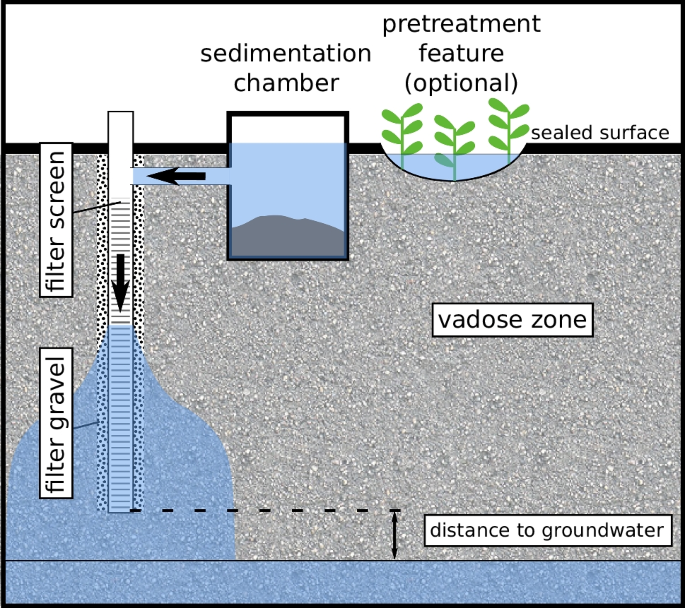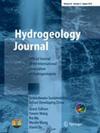Os poços na zona vadosa podem ser retrolavados para recuperar a capacidade de infiltração? Conceito e teste de laboratório
IF 2.3
3区 地球科学
Q2 GEOSCIENCES, MULTIDISCIPLINARY
引用次数: 0
Abstract
Abstract Vadose zone wells (VZW), or drywells, allow for high infiltration rates combined with small area demand. Nevertheless, they are rarely used for managed aquifer recharge, since turbid water leads to gradual clogging and a reduction in infiltration capacity. Established redevelopment measures require backflushing, which is commonly considered impossible for VZWs, making them “non regenerable”. In this study, the possibility of backflushing a VZW is discussed. Key to the underlying approach is isolating the lower (clogged) section of a well and saturating its surrounding with water by infiltration via the upper (unclogged) screen. Subsequently, underpressure sucks water from the surrounding soil into the isolated section. The approach was tested with and without a gravel pack, on laboratory scale, showing a successful reversal of flow direction in both cases. The degree of redevelopment was quantified by measuring the drainage time of the well, which increased from initially 45 s without gravel pack and 40 s with gravel pack to 9,500 and 11,000 s, respectively, after clogging. After backflushing, the well with gravel pack showed a median drainage time of 95 s, which remained stable over ten cycles of clogging and backflushing. In contrast, drainage time of the well without gravel pack increased continuously to >170 s, even after vibrator application. In conclusion, it can be stated that the backflush of a VZW with the presented approach is possible and has an effect on the well’s infiltration capacity, though it seems more effective for wells with gravel pack.

涉水带的井是否可以反冲洗以恢复渗入能力?概念及实验室测试
真空带井(VZW)或干井具有高渗透速率和小面积需求的特点。然而,它们很少用于管理含水层补给,因为浑浊的水会导致逐渐堵塞和渗透能力降低。现有的重建措施需要反冲洗,而这通常被认为是不可能的,使它们成为“不可再生的”。在本研究中,讨论了反冲洗VZW的可能性。底层方法的关键是隔离井的下部(堵塞的)部分,并通过上部(未堵塞的)筛管渗透水使其周围饱和。随后,欠压将周围土壤中的水吸到被隔离的部分。在实验室规模上,对该方法进行了砾石充填和不砾石充填的测试,结果表明,在两种情况下,该方法都成功地逆转了流动方向。通过测量井的排水时间来量化再开发的程度,堵漏后,井的排水时间分别从最初的无砾石充填45秒和砾石充填40秒增加到9500秒和11000秒。充填砾石的井经过反冲洗后,平均排水时间为95 s,在堵塞和反冲洗的10次循环中保持稳定。相比之下,未充填砾石的井在使用振动器后,排水时间持续增加至170 s。综上所述,采用该方法对VZW进行反冲洗是可能的,并且会对井的渗透能力产生影响,尽管对于砾石充填的井似乎更有效。
本文章由计算机程序翻译,如有差异,请以英文原文为准。
求助全文
约1分钟内获得全文
求助全文
来源期刊

Hydrogeology Journal
地学-地球科学综合
CiteScore
5.40
自引率
7.10%
发文量
128
审稿时长
6 months
期刊介绍:
Hydrogeology Journal was founded in 1992 to foster understanding of hydrogeology; to describe worldwide progress in hydrogeology; and to provide an accessible forum for scientists, researchers, engineers, and practitioners in developing and industrialized countries.
Since then, the journal has earned a large worldwide readership. Its peer-reviewed research articles integrate subsurface hydrology and geology with supporting disciplines: geochemistry, geophysics, geomorphology, geobiology, surface-water hydrology, tectonics, numerical modeling, economics, and sociology.
 求助内容:
求助内容: 应助结果提醒方式:
应助结果提醒方式:


